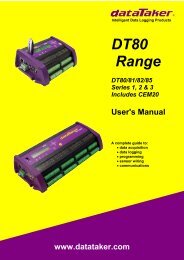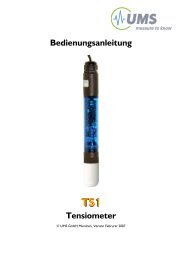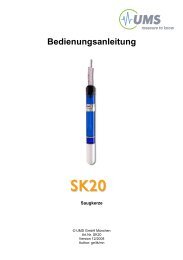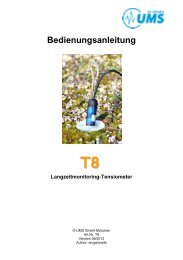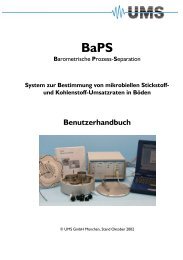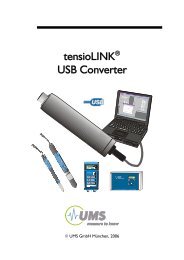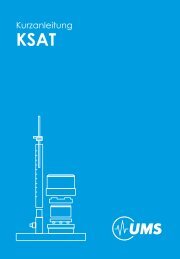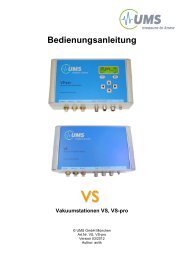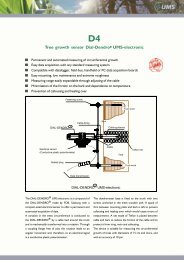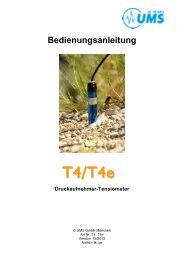KD2 Manual - UMS
KD2 Manual - UMS
KD2 Manual - UMS
Create successful ePaper yourself
Turn your PDF publications into a flip-book with our unique Google optimized e-Paper software.
<strong>KD2</strong><br />
Thermal Properties<br />
Analyzer<br />
User’s <strong>Manual</strong><br />
version 1.0<br />
Decagon Devices, Inc.
<strong>UMS</strong> GmbH<br />
Gmunderstr. 37<br />
D-81379 München<br />
Tel. +49 (0) 89-12 66 52-0<br />
Fax: +49 (0) 89-12 66 52-20<br />
ums@ums-muc.de<br />
www.ums-muc.de<br />
©2001 Decagon Devices, Inc.<br />
All rights reserved.<br />
Decagon Devices, Inc.<br />
950 NE Nelson Court<br />
P.O. Box 835<br />
Pullman WA 99163
Contents<br />
<strong>KD2</strong> User’s Guide<br />
Table of Contents<br />
1. Introduction . . . . . . . . . . . . . . . . . .1<br />
About the <strong>KD2</strong> . . . . . . . . . . . . . . . . 1<br />
<strong>KD2</strong> Specifications . . . . . . . . . . . . 2<br />
Contact Information . . . . . . . . . . . 2<br />
Warranty Information . . . . . . . . . 3<br />
Seller’s Liability . . . . . . . . . . . . . . . 3<br />
2. Operation . . . . . . . . . . . . . . . . . .5<br />
Turning it on . . . . . . . . . . . . . . . . . . 5<br />
Taking Measurements . . . . . . . . . 6<br />
How the <strong>KD2</strong> takes measurements 11<br />
3. Care and Maintenance . . . . . . .13<br />
Cleaning . . . . . . . . . . . . . . . . . . . . . 13<br />
Battery Replacement . . . . . . . . . . 13<br />
Caring for the Probe . . . . . . . . . . 15<br />
4. Theory . . . . . . . . . . . . . . . . . . . . .16<br />
Declaration of Conformity . . . . . .22<br />
i
<strong>KD2</strong> User’s Guide<br />
Table of Contents<br />
ii
<strong>KD2</strong> User’s Guide<br />
Introduction<br />
1. Introduction<br />
Welcome to your new <strong>KD2</strong> Thermal Properties<br />
Analyzer. This guide is designed to help<br />
you understand and use your instrument to<br />
the best of its capability.<br />
About the <strong>KD2</strong><br />
The <strong>KD2</strong> is a compact, portable meter used to<br />
measure thermal properties. It consists of a<br />
hand-held readout and a single-needle sensor<br />
that can be inserted into the medium you<br />
wish to measure. A reading is initiated by<br />
pressing the left button on the readout. The<br />
controller waits for 90 seconds to ensure temperature<br />
stability, then heats the probe for 30<br />
seconds. At the end of the reading, the controller<br />
computes the thermal properties based<br />
on the measurements made during the heating<br />
period of the probe. This data is used to<br />
calculate thermal conductivity, thermal resistivity,<br />
and thermal diffusivity. Further details<br />
about the measurements and how they’re<br />
1
<strong>KD2</strong> User’s Guide<br />
Introduction<br />
made are given in chapters 2 and 3 of this<br />
guide.<br />
<strong>KD2</strong> Specifications<br />
Measurement Speed: 2 minutes<br />
Accuracy:<br />
• 5% Thermal Conductivity/Resistivity<br />
• 10% Thermal Diffusivity<br />
Power: 3.0V CR2-type lithium-ion battery<br />
Weight: 148g (5 oz.)<br />
Operating Environment: 5 to 40°C<br />
Range of Measurement:<br />
• K (thermal conductivity): 0.1—2 Wm -1 C -1<br />
• D (thermal diffusivity): 0.1—1.0 mm 2 s -1<br />
• R (thermal resistivity): 0.5—10mC W -1<br />
Sensor:<br />
• Needle length: 60mm<br />
• Needle diameter: 0.9mm<br />
• Cable length: 72cm<br />
Contact Information<br />
If you need to contact Decagon for customer<br />
support or any other questions, you can reach<br />
us by any of the following:<br />
• Email us at kd2@decagon.com<br />
2
<strong>KD2</strong> User’s Guide<br />
Introduction<br />
• Send us a fax at: (509) 332-5158<br />
• Call us at: 1-800-755-2751 (US and Canada<br />
only) or 509-332-2756.<br />
Warranty Information<br />
The <strong>KD2</strong> has a 30-day satisfaction guarantee<br />
and a one-year warranty.<br />
Seller’s Liability<br />
Seller warrants new equipment of its own<br />
manufacture against defective workmanship<br />
and materials for a period of one year from<br />
date of receipt of equipment (the results of<br />
ordinary wear and tear, neglect, misuse, accident<br />
and excessive deterioration due to corrosion<br />
from any cause are not to be considered<br />
a defect); but Seller’s liability for defective<br />
parts shall in no event exceed the furnishing<br />
of replacement parts F.O.B. the factory where<br />
originally manufactured. Material and equipment<br />
covered hereby which is not manufactured<br />
by Seller shall be covered only by the<br />
warranty of its manufacturer. Seller shall not<br />
be liable to Buyer for loss, damage or injuries<br />
to persons (including death), or to property<br />
or things of whatsoever kind (including, but<br />
3
<strong>KD2</strong> User’s Guide<br />
Introduction<br />
not without limitation, loss of anticipated<br />
profits), occasioned by or arising out of the<br />
installation, operation, use, misuse, nonuse,<br />
repair, or replacement of said material and<br />
equipment, or out of the use of any method<br />
or process for which the same may be<br />
employed. The use of this equipment constitutes<br />
Buyer’s acceptance of the terms set forth<br />
in this warranty. There are no understandings,<br />
representations, or warranties of any kind,<br />
express, implied, statutory or otherwise<br />
(including, but without limitation, the implied<br />
warranties of merchantability and fitness for a<br />
particular purpose), not expressly set forth<br />
herein.<br />
4
<strong>KD2</strong> User’s Guide<br />
Operation<br />
2. Operation<br />
The <strong>KD2</strong> is designed to be a simple, easy to<br />
use instrument that will allow you to make<br />
quick and accurate thermal properties measurements.<br />
Following are some instructions<br />
on how the instrument functions.<br />
Turning it on<br />
To turn on the <strong>KD2</strong>, press the left button (I)<br />
once. The LCD display will appear, showing<br />
the previous measurement taken.<br />
Wm -1 C -1<br />
2 3.0 C |<br />
5
<strong>KD2</strong> User’s Guide<br />
Operation<br />
Taking Measurements<br />
The <strong>KD2</strong> measures thermal conductivity,<br />
resistivity, and diffusivity at the same time<br />
from one measurement, but can only display<br />
one reading at a time after the measurement<br />
is made. The right (II) button is used to toggle<br />
through the calculated readings after the<br />
measurement has been made. To begin a<br />
measurement, press the left (I) button to turn<br />
on the instrument. The instrument will be in<br />
the same measurement mode as it was when<br />
it was last used (thermal conductivity, thermal<br />
diffusivity, or thermal resistivity mode) and<br />
will display the last reading taken.<br />
NOTE!: It is important to wait for about 5<br />
minutes between readings if the probe is<br />
left in the same location! If multiple measurements<br />
of a sample are made too rapidly<br />
in succession, the sample’s temperature will<br />
not have had enough time to equilibrate from<br />
the previous reading, and the resulting measurement<br />
will be inaccurate. For best results,<br />
the sample should be as close to equilibrium<br />
as possible. An ideal environment for equilibration<br />
can be accomplished by placing the<br />
6
<strong>KD2</strong> User’s Guide<br />
Operation<br />
<strong>KD2</strong> probe and sample in an isothermal<br />
chamber or styrofoam box.<br />
How to Start the Measurement<br />
Once the instrument is on, do the following:<br />
1. Carefully insert the probe into your<br />
medium.<br />
2. Press the left button to begin the measurement<br />
process. The instrument will<br />
first equilibrate for 90 seconds. During<br />
this time you will be able to see that it is<br />
equilibrating by the blinking “hourglass”<br />
icon below the value. The temperature<br />
measured by the probe will be displayed<br />
in the lower right corner of the screen:<br />
Wm -1 C -1<br />
2 0.0 C<br />
hourglass icon<br />
temperature<br />
7
<strong>KD2</strong> User’s Guide<br />
Operation<br />
Note!: Make sure to watch the temperature<br />
during the equilibration stage to<br />
make sure it doesn’t drastically fluctuate<br />
or rapidly change. If the temperature is<br />
still rapidly changing, pull the probe out<br />
of the sample and wait until the sample<br />
temperature is stable before measuring<br />
again.<br />
3. After equilibrating, it begins its 30-second<br />
heating and measurement cycle. During<br />
this stage of measurement you will see a<br />
blinking thermometer icon appear, and<br />
the temperature reading will increase:<br />
Wm -1 C -1<br />
2 7.0 C |<br />
thermometer icon<br />
4. When the reading is finished, the checkered<br />
“finish line” flag will blink on the<br />
screen, and a final reading will be dis-<br />
8
<strong>KD2</strong> User’s Guide<br />
Operation<br />
played along with the sample temperature:<br />
Wm -1 C -1<br />
2 3.0 C |<br />
“finished” icon<br />
Thermal Conductivity<br />
To display the measurement in terms of thermal<br />
conductivity, press the right (II) button<br />
until the thermal conductivity is displayed in<br />
Wm -1 C -1 (watts per meter-degree Celsius):<br />
Wm -1 C -1<br />
2 3.0 C |<br />
9
<strong>KD2</strong> User’s Guide<br />
Operation<br />
Thermal Resistivity<br />
To display the measurement in terms of thermal<br />
resistivity, press the right (II) button until<br />
the thermal resistivity is displayed in mC W -1<br />
(meter-degrees C per watt):<br />
m C W -1<br />
2 0.0 C |<br />
If the value shown for thermal resistivity is<br />
9.99, this indicates that your sample is out of<br />
range for the <strong>KD2</strong> to measure.<br />
Thermal Diffusivity<br />
To display the measurement in terms of thermal<br />
diffusivity, press the right (II) button until<br />
10
<strong>KD2</strong> User’s Guide<br />
Operation<br />
the thermal diffusivity is displayed in mm 2 s -1<br />
(square millimeters per second):<br />
mm 2 s -1<br />
2 0.0 C |<br />
Turning it off<br />
The <strong>KD2</strong> will shut off automatically after 5<br />
minutes of inactivity. To turn it back on, press<br />
the left (I) button once.<br />
How the <strong>KD2</strong> takes measurements<br />
The <strong>KD2</strong>’s sensor needle contains both a<br />
heating element and a thermistor. The controller<br />
module contains a battery, a 16-bit<br />
microcontroller/AD converter, and power<br />
control circuitry.<br />
When you begin a measurement, the microcontroller<br />
waits for 90 seconds for temperature<br />
stability, then applies a known amount of<br />
current for 30 seconds to a heater in the<br />
11
<strong>KD2</strong> User’s Guide<br />
Operation<br />
probe that has an accurately known resistance.<br />
The microprocessor calculates the<br />
amount of power supplied to the heater. The<br />
probe’s thermistor measures the changing<br />
temperature for 30 seconds while the microprocessor<br />
stores the data. At the end of the<br />
reading, the controller computes the thermal<br />
conductivity and diffusivity using the change<br />
in temperature (∆T) vs. time data. Thermal<br />
resistivity is computed as the reciprocal of<br />
thermal conductivity.<br />
12
<strong>KD2</strong> User’s Guide<br />
Care and Maintenance<br />
3. Care and Maintenance<br />
Your <strong>KD2</strong> should require a minimum amount<br />
of maintenance. Following are instructions for<br />
cleaning and battery replacement, as well as<br />
considerations for the <strong>KD2</strong> probe.<br />
Cleaning<br />
The <strong>KD2</strong>’s controller is stainless steel. If it<br />
needs cleaning, do so with a damp cloth. Do<br />
not immerse it in water. Clean the LCD<br />
readout with a soft, damp cloth moistened<br />
with water or a glass cleanser. Do not use tissue<br />
or other wood-based fibers, as they can<br />
scratch the plastic LCD screen.<br />
Battery Replacement<br />
The <strong>KD2</strong> uses a 3.0V CR-2 type Lithium-ion<br />
battery. It typically should last for about 1000<br />
measurements. If the battery charge is getting<br />
low, a low-battery indicator icon will appear<br />
in the lower right corner of the LCD screen<br />
when the heater comes on (an occasional low<br />
13
<strong>KD2</strong> User’s Guide<br />
Care and Maintenance<br />
battery indication does not necessarily mean<br />
the battery needs replacing):<br />
Wm -1 C -1<br />
2 0.0 C<br />
+<br />
|<br />
If this screen appears continually, do the following<br />
to replace the battery:<br />
1. Unscrew the small screw on the back of<br />
the <strong>KD2</strong> case.<br />
2. Lift the back shell off to reveal the battery:<br />
battery<br />
location<br />
14
<strong>KD2</strong> User’s Guide<br />
Care and Maintenance<br />
3. Remove the battery and replace it with<br />
the new one, making sure to orient the<br />
battery the same way you removed it.<br />
Caring for the Probe<br />
The <strong>KD2</strong> sensor contains a heater and thermistor<br />
that are essential for the function of the<br />
instrument. Care should be taken to prevent<br />
bending the probe. The probe itself is stainless<br />
steel, so it may be cleaned with a wet<br />
cloth or sponge if it becomes dirty.<br />
15
<strong>KD2</strong> User’s Guide<br />
Theory<br />
4. Theory<br />
<strong>KD2</strong> calculates its values for thermal conductivity<br />
(K), resistivity (R), and diffusivity (D) by<br />
monitoring the dissipation of heat from a line<br />
heat source given a known voltage.<br />
The equation for radial heat conduction in a<br />
homogeneous, isotropic medium is given by<br />
∂<br />
∂t<br />
2<br />
⎛ ∂ T<br />
= κ<br />
⎜ + r<br />
2<br />
⎝ ∂r<br />
T −1<br />
∂T<br />
⎞<br />
⎟<br />
∂r<br />
⎠<br />
(1)<br />
where T is temperature (°C), t is time (s), κ is<br />
thermal diffusivity (m 2 s -1 ), and r is radial distance<br />
(m). When a long, electrically heated<br />
probe is introduced into a medium, the rise in<br />
temperature from an initial temperature, T 0 , at<br />
some distance, r, from the probe is<br />
16
<strong>KD2</strong> User’s Guide<br />
Theory<br />
T − T<br />
0<br />
2<br />
⎛ q ⎞ ⎛ − r<br />
=<br />
⎜<br />
⎟Ei<br />
⎜<br />
⎝ 4πλh<br />
⎠ ⎝ 4κt<br />
(2)<br />
where q is the heat produced per unit length<br />
per unit time (W m -1 ), λ h is the thermal conductivity<br />
of the medium (W m -1 c -1 ), and Ei is<br />
the exponential integral function<br />
2 2 2<br />
− ∫ ∞<br />
⎛ 1 ⎞<br />
⎛ r ⎞ r ⎛ r ⎞<br />
Ei ⎜ ⎟<br />
⎜ 4 ⎟ 4 ⎜ 8 ⎟<br />
⎝ u ⎠<br />
⎝ κt<br />
⎠ κt<br />
⎝ κ t<br />
a<br />
⎠<br />
( − a) = exp( − u) du = −γ<br />
− ln⎜<br />
⎟ + − ⎜ ⎟ + ...<br />
(3)<br />
with a = r 2 /4κt and γ is Euler's constant<br />
(0.5772…). When t is large, the higher order<br />
terms can be ignored, so combining Eqs. (2)<br />
and (3) yields<br />
T − T<br />
0<br />
(4)<br />
It is apparent from the relationship between<br />
thermal conductivity and ∆T = T-T 0 , shown in<br />
⎞<br />
⎟<br />
⎠<br />
2<br />
q ⎛<br />
⎛ r ⎞<br />
()<br />
⎟ ⎞<br />
≅ ⎜<br />
ln t − γ − ln<br />
⎜<br />
⎟<br />
4πλh<br />
⎝<br />
⎝ 4κ<br />
⎠⎠<br />
2<br />
17
<strong>KD2</strong> User’s Guide<br />
Theory<br />
Eq. (4), that ∆T and ln(t) are linearly related<br />
with a slope m = (q/4πλ h ). Linearly regressing<br />
∆T on ln(t) yields a slope that, after rearranging,<br />
gives the thermal conductivity as<br />
λ<br />
h<br />
≅<br />
q<br />
4πm<br />
(5)<br />
where q is known from the power supplied<br />
to the heater. The diffusivity can also be<br />
obtained from Eq. (4). The intersection of the<br />
regression line with the t axis (∆T = 0) gives<br />
ln<br />
⎛<br />
⎛ r<br />
⎞⎞<br />
( t ) ⎜<br />
⎜<br />
⎟<br />
⎟ 0<br />
= γ + ln<br />
⎝ ⎝ 4κ<br />
⎠⎠<br />
(6).<br />
From the calculated t 0 (from the intercept of<br />
∆T vs. ln(t)) and finite r, Eq. (6) gives the diffusivity.<br />
Because the higher order terms of Eq. (3)<br />
have been neglected, Eq. (4) is not exact.<br />
However, if the slope and intercept are computed<br />
only for ∆T and ln(t) values, where t is<br />
2<br />
18
<strong>KD2</strong> User’s Guide<br />
Theory<br />
large enough to ignore the higher order<br />
terms, Eq. (5) and (6) give correct values for<br />
λ h and κ. To verify these relationships, realistic<br />
values of λ h and κ were supplied to Eq.<br />
(2), varying both λ h and volumetric heat<br />
capacity (ρc p ), and the resulting slope and<br />
intercept tabulated for t ranging from 1 to 30<br />
s. Plots of slope vs. theoretical λ h and<br />
ln(intercept) vs. ln(theoretical κ) show an<br />
exact linear relationship (Fig. 1 and 2, respectively)<br />
with low cross-covariance.<br />
Figure 1: calculated λ h vs. theoretical λ h<br />
19
<strong>KD2</strong> User’s Guide<br />
Theory<br />
Figure 2: calculated κ vs. theoretical κ<br />
The experimental analysis differs from the<br />
theoretical shown in Eq. (2) in that the heater<br />
and sensor have their own conductivity and<br />
diffusivity, which, in general, differ from<br />
those of the medium being measured. We<br />
have shown experimentally that the relationships<br />
in Eq. (5) and (6) still allow calculations<br />
of λ h and κ, but empirical factors must be<br />
introduced to correct for heater thermal properties.<br />
20
<strong>KD2</strong> User’s Guide<br />
Theory<br />
Assumptions: The thermal conductivity<br />
measurement assumes several things: the<br />
long heat source can be treated as a infinitely<br />
long heat source, the medium is both homogeneous<br />
and isotropic, and a uniform initial<br />
temperature, T 0 . Although these assumptions<br />
are not true in the strict sense, they are adequate<br />
for accurate thermal properties measurements.<br />
21
<strong>KD2</strong> User’s Guide<br />
Declaration of Conformity<br />
Declaration of Conformity<br />
Application of Council<br />
Directive:<br />
89/336/EEC<br />
Standards to which<br />
conformity is declared:<br />
EN55022:1987<br />
EN500082-1:1992<br />
Manufacturer’s Name: Decagon Devices, Inc.<br />
950 NE Nelson Court<br />
Pullman WA 99163 USA<br />
Type of Equipment: Thermal Properties Meter<br />
Model Number:<br />
<strong>KD2</strong><br />
Year of First Manufacture: 2001<br />
This is to certify that the <strong>KD2</strong> Thermal Properties<br />
Meter, manufactured by Decagon<br />
Devices, Inc., a corporation based in Pullman,<br />
WA, USA meets or exceeds the standards for<br />
CE compliance as per the Council Directives<br />
noted above. All instruments are built at the<br />
factory at Decagon and pertinent testing documentation<br />
is freely available for verification.<br />
22
Index<br />
<strong>KD2</strong> User’s Guide<br />
Index<br />
A<br />
accuracy 2<br />
B<br />
battery<br />
replacing 13<br />
type 13<br />
C<br />
CE<br />
compliance 22<br />
cleaning 13<br />
contact information 2<br />
D<br />
D (diffusivity) 16<br />
E<br />
email 2<br />
23
<strong>KD2</strong> User’s Guide<br />
Index<br />
F<br />
fax number 2<br />
K<br />
K (thermal conductivity) 16<br />
<strong>KD2</strong><br />
overview 1<br />
specifications 2<br />
L<br />
low battery indicator 13<br />
M<br />
maintenance 13<br />
measurement<br />
method 11<br />
measurement range 2<br />
O<br />
off(turning off) 11<br />
on(turning on) 5<br />
operation<br />
24
on 5<br />
<strong>KD2</strong> User’s Guide<br />
Index<br />
P<br />
probe<br />
maintenance 15<br />
specifications 2<br />
R<br />
R (thermal resistivity) 16<br />
range 2<br />
S<br />
seller’s liability 3<br />
specifications 2<br />
T<br />
telephone number 2<br />
temperature equilibrium 6<br />
theory 16<br />
assumptions 21<br />
thermal conductivity<br />
calculation 18<br />
25
<strong>KD2</strong> User’s Guide<br />
Index<br />
thermal diffusivity<br />
calculation 18<br />
units 11<br />
thermal resistivity<br />
computed 12<br />
units 10<br />
U<br />
units<br />
thermal diffusivity 11<br />
thermal resistivity 10<br />
W<br />
warranty 3<br />
26




